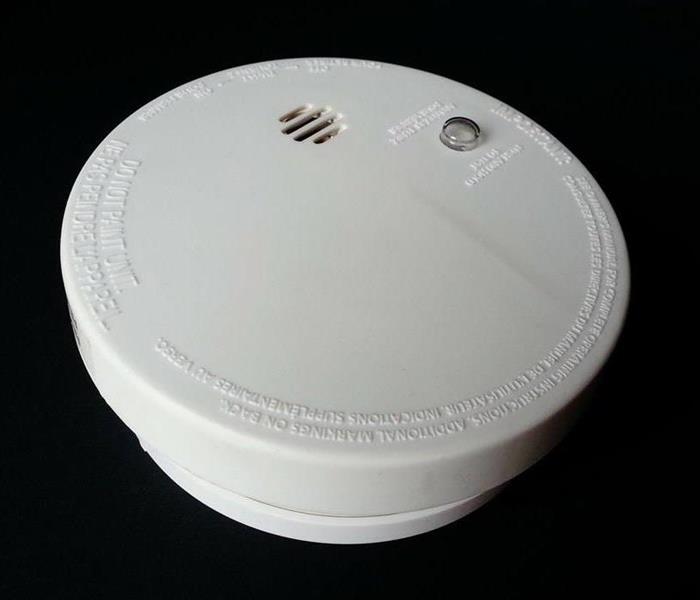The Key Differences Between Photoelectric & Ionization Smoke Detectors
3/1/2021 (Permalink)
Learn how to choose the right smoke detector for your property!
The average property owner changes their smoke detectors' batteries at least twice a year and performs testing every month. But most have no idea what type of smoke detectors they have. Do you know what type of smoke alarms are present on your property?
According to the National Fire Protection Association, over 354,000 household fires occur each year, resulting in an average of 2,600 casualties and over 11,000 injuries. The majority of these fire-related deaths happen in the middle of the night while people are asleep.
It's easy to see how important well-placed & high-quality smoke detectors are.
There are two major types of smoke detectors - photoelectric and ionization. Each has a sensor that senses smoke and fire in various ways based on where the fire started.
Understanding and recognizing the differences between the two types of smoke detectors will help you make the right decision in choosing the smoke alarms protecting your property.
Photoelectric vs. Ionization smoke detectors
When looking for the best smoke detector for your property, you'll probably come across a face-off between ionization and photoelectric smoke detectors. Both happen to have valuable features for property owners concerned about the danger of fire and smoke. When you look closely, though, you'll find that the devices function in quite different ways.
So, which alarm should you choose? Although both types of smoke detectors are designed to detect any type of fire, regardless of the cause, each has benefits and can provide an earlier warning than the other, based on the fire source. Let's see how these devices work.
Both photoelectric and ionization smoke detectors protect against fire damage, but which is better?
To understand this, let's look at the differences between the two:
- Photoelectric smoke detectors respond much quicker (15 to 50 mins faster) to smoldering fires that move slowly but create the most smoke - the element of household fires most responsible for casualties.
- Ionization smoke detectors respond to fast flame fires (fires with rapidly spreading flames) slightly quicker (30-90 seconds) than photoelectric alarms.
In all fire scenarios, regardless of material or type, a well-designed photoelectric alarm would typically outperform ionization alarms, according to the NFPA.
Key Difference:
When it comes to identifying small smoke particles, ionization smoke detectors are usually more sensitive than photoelectric smoke detectors. Photoelectric detectors are comparatively more sensitive to large smoke particles.
What are Photoelectric Smoke Detectors?
Photoelectric smoke detectors are designed to quickly detect changes caused by smoke in the intensity of light. It consists of a light-sensitive sensor and a light-emitting diode. Smoke enters the chamber and reflects light, triggering the alarm to go off.
According to the National Fire Protection Association, these detectors are most efficient at sounding when a fire starts from a smoldering source, such as a lit cigarette that falls onto a couch cushion. Before a fire erupts, smoldering flames could fill a house with harmful gases.
Photoelectric smoke alarms are more responsive to smoldering fires.
Examples:
- Fires caused by burning clothes.
- Fires caused by burning furniture.
What are Ionization Smoke Detectors?
The design of ionization smoke detectors is highly sophisticated. They consist of a chamber made up of two electrically charged plates and a small bit of radioactive material, which ionizes the air that travels through them and causes a current. When smoke enters this chamber, The ion flow is interrupted, and the alarm goes off.
As compared to photoelectric smoke detectors, these give an earlier warning when it comes to smoke from flaming fires.
Ionization smoke alarms are more responsive to flaming fires.
Examples:
- Kitchen grease fires.
- Fire from burning paper.
In certain fire cases, each type of smoke alarm's key feature can be vital to life protection. When it comes to home-fatal fires, be it day or night, a significant number of flaming fires and a large number of smoldering fires occur every year. You can't know what kind of fire you'll get in your house or when it'll happen. To be considered acceptable, smoke detector technology must work well in all forms of fires to provide residents an early fire warning, whether they are sleeping or awake.
The best solution
Installing a combination of Ionization and Photoelectric smoke detectors will provide the safest possible environment for your family. It's too dangerous to pick one over the other, and there's no way of predicting what kind of fire hazard your home may face. Both ionization and photoelectric technologies are utilized in some smoke detectors. These smoke detectors are referred to as "dual" smoke detectors, and they are commonly available in home improvement shops and online, in a range of price points and from a variety of brands.
As a property owner, you want to do everything to take advantage of the life-saving smoke and fire warning technology available.
Concluding thoughts
We hope you enjoyed learning about the two different types of fire detectors. Contact us today if you have any questions or need help installing a smoke alarm. SERVPRO of South Cobb specializes in fire mitigation services and is available 24/7.

 24/7 Emergency Service
24/7 Emergency Service
